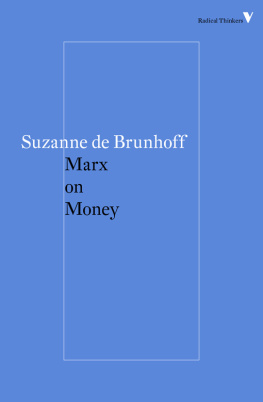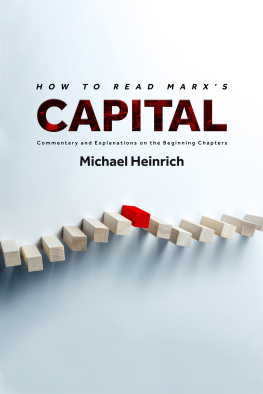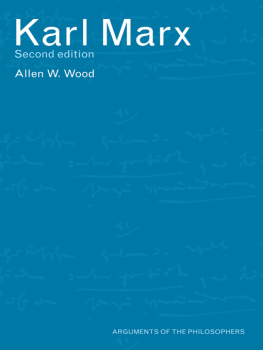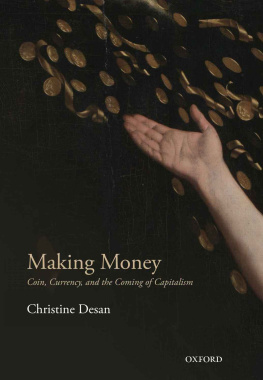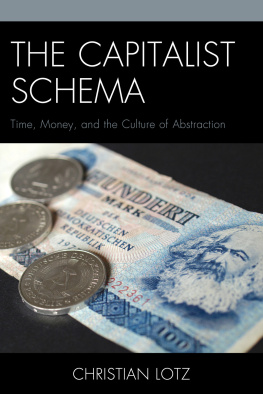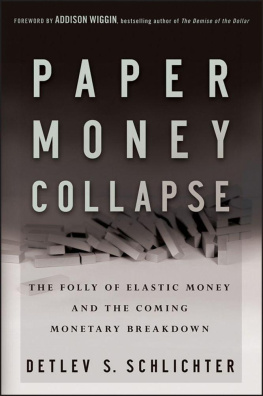MARX
ON
MONEY
SUZANNE
DE BRUNHOFF
Translated by
Maurice J. Goldbloom
Preface by
Duncan K. Foley

This edition published by Verso 2015
First published in English by Urizen Books 1976
First published as La Monnaie Chez Marx
ditions sociales 1973
Translation Maurice J. Goldbloom 1976, 2015
All rights reserved
The moral rights of the author have been asserted
1 3 5 7 9 10 8 6 4 2
Verso
UK: 6 Meard Street, London W1F 0EG
US: 20 Jay Street, Suite 1010, Brooklyn, NY 11201
www.versobooks.com
Verso is the imprint of New Left Books
ISBN-13: 978-1-78478-226-9 (PB)
eISBN-13: 978-1-78478-228-3 (US)
eISBN-13: 978-1-78478-227-6 (UK)
British Library Cataloguing in Publication Data
A catalogue record for this book is available from the British Library
Library of Congress Cataloging-in-Publication Data
A catalog record for this book is available from the Library of Congress
Printed in the US by Maple Press
CONTENTS
T his little book is a guide to Marxs views on money. It is a point of access to ideas that have been much neglected in twentieth-century debates on monetary theory and policy, but provide, I think, valuable and plausible scientific alternatives to the views that have dominated these debates.
The first thing a student of money notices is that in a monetary economy the movements of money and commodities are intertwined. At the level of the individual transaction some means of payment moves in one direction and some commodity moves in the opposite direction. The theoretical question then arises as to which is the determining factor. Does the movement of money determine the movement of commodities or the movement of commodities determine the movement of money? Even if we come to acknowledge a large measure of mutual determination between the movements of money and commodities this question still provides the starting point for theories of money, and in the end we will want to know from our theory which aspect is the primary determining factor.
Consider for example the early form of the Quantity Theory of Money. Since in every transaction a certain amount of money changes places with commodities having a certain price, it is clear that the total money price of commodities that a given quantity of money can exchange for in a period is proportional to the average number of times each unit of money moves in the period, its velocity. This identity is the quantity equation of money. The quantity theory asserts that all existing money participates equally in this circulation, so that the existing quantity of money, and velocity, which depends on social and technical factors outside the monetary sphere, determine the total price of commodities exchanged in a period. In this theory the proximate determinant of changes in the amounts of commodities exchanged is the effort of individuals to acquire or get rid of money. The quantity theory usually argues that in long-run equilibrium the money prices of commodities will adjust proportionately to the quantity of existing money, so that the actual quantities of commodities exchanged in the long-run equilibrium are determined by nonmonetary factors like tastes and technology. Still it is clear that the starting point of the early quantity theory is the idea that movements of money determine movements of commodities. Keynes and those who adopt his monetary theory by and large take up a similar, though somewhat modified position. Changes in asset prices, interest rates, and, as a consequence, in spending within Keynes theoretical framework are the result of the attempts of individual wealth-holders to adjust their holdings of money to some desired level. Again, changes in commodity flows are in large part determined by monetary changes.
As this book makes clear, Marx started from the opposite view that the movement of commodities is largely determined outside the monetary sphere, and that movements of money in most cases are determined by those commodity movements. Marx thus emphasizes a view of money as a medium through which commodity exchange takes place, a medium that transmits, but in most instances does not create, impulses of spending that originate outside itself. Units of money are moved by the exchange of commodities as molecules of water are displaced by a wave propagating through a pond. This general point of view is well illustrated, as de Brunhoff shows in the first part of this book, by Marxs discussion of the quantity equation, on which he bases his law of circulation. Not only the quantities of commodities produced and exchanged and the transactions velocity of money, but also the money prices of commodities are taken by Marx as determined outside the circulation process. It is the quantity of circulating money in Marxs view that adjusts to satisfy the quantity equation, a sharp reversal of the quantity theory interpretation.
This view that money is primarily a transmitting medium rather than an active disturbing element in the economy also carries over to Marxs complex and incomplete discussion of credit and interest. Here interest appears as a simple quantitative division of total profit, with no power to determine the rate of profit or the rate of investment. This is in sharp contrast to Keynes view that the rate of interest is an important determining factor in investment through its influence on the marginal efficiency of capital (the profit rate on current investment).
Despite the fact that Marx sees movements of money as primarily determined by movements of commodities, he does not argue that money is neutral or a veil, or that it does not matter. For example, Marx emphasizes that the existence of money and the possibility of hoarding are preconditions for a general crisis of overproduction in a capitalist economy. This is one instance where Marxs unified treatment of macroeconomics and microeconomics is clearly advantageous. Marx never separates the theoretical terms in which he discusses the reproduction of particular capitals from the terms in which he discusses the reproduction of the capitalist system as a whole. At each level Marx explicitly analyzes the role and movement of money and makes clear its qualitative importance. In this way he avoids the theoretical embarrassment of having distinct and incompatible theories of macroeconomics and microeconomics. Modern bourgeois economics begins with a theory of the firm and the household which abstracts from the existence of money and assumes that commodities can be exchanged directly for each other without the intervention of money. This type of theory leads to a notion of equilibrium for the economy as a whole that rules out crises of overproduction and widespread unemployment of labor. To explain these important features of capitalist economic development bourgeois economics adopts a quite different theory, developed from the work of Keynes, which is unfortunately inconsistent with the bourgeois microeconomic theory of the firm and household in several ways. A leading theoretical problem in modern bourgeois economics is to reconcile these two theories with each other in an appropriate way. Marx avoids this problem by creating a unified treatment of individual capital and the capitalist system as a whole, a treatment which at every level acknowledges the role that money plays. This feature should recommend the study of his theory of money to modern students of monetary problems.

